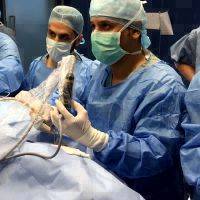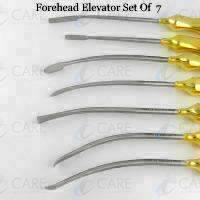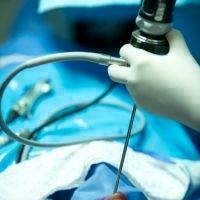Endoscopic Facelift Surgery
Endoscopic facelift is an operation aimed at rejuvenating the face using endoscopic techniques. The beginning of the use of endoscopic technologies in facial aesthetic surgery falls on the end of the 90s of the last century. The advantages of endoscopic facelift over traditional techniques are obvious – small incisions (1 to 3 cm), small trauma surgery, a short recovery period, the minimum number of postoperative complications and high patient satisfaction.
The biggest advantage of endoscopic facelift is a small skin incisions, which are usually hidden in the reach of the eye. However, this kind of surgery is not applicable to all patients. The most suitable candidates are people with a small ptosis of tissues and preserved skin tone. Patients with significant ptosis of tissues and large excess skin are candidates for traditional facelift techniques.
With the help of endoscopic technique it is possible to operate both the entire face and individual zones. The most commonly endoscopic lift is used in the upper part of the face, for eyebrow and forehead lift.
The second most common zone is the middle zone of the face. Very often the tightening of the upper and middle zone of the face is combined in one operation. Less common are the operations on the lower part of the face and neck.
Indications for endoscopic facelift are:
- drooping eyebrows and forehead;
- horizontal and vertical wrinkles of the forehead and interbrother area;
- overhanging of the skin in the upper eyelid due to ptosis of the eyebrows;
- tired face;
- radial wrinkles in the area of the outer corners of the eyes (crow’s feet);
- omitted corners outer of the eyes;
- initial manifestations of ptosis of the tissues of the cheeks and neck;
- deep nasolabial folds.
Contraindications:
- High blood pressure;
- Serious cardiovascular diseases;
- Diabetes;
- Thyroid gland diseases;
- Coagulation disorder;
- Severe concomitant diseases of internal organs;
- Infectious diseases;
- Oncological diseases;
Operation time: The duration of the operation depends on which lifting complex is carried out, usually it takes from 1 to 4 hours.
Anesthesia: General or combined intravenous anesthesia.
Examination before surgery: The examination period is 1-3 days (depending on the time that you have).
Location: The operation is performed in a hospital. Usually it is necessary to spend in a hospital 1-3 days.
Incisions: Small incisions in the scalp from 2 to 5, with a lift of the middle zone of the face are supplemented by intraoral incisions.
Possible side effects: insignificant soreness; edema, from mild to moderate; bruises as after bruises; temporary numbness of the zone of intervention.
Risks: Infection, hematoma formation, long healing, local alopecia, asymmetry of the eyebrows.
Recovery:
Discomfort and pain almost none. After 1 week, bruises and swelling disappear. The patient wears a compression bandage for the first 5 days. Sutures are removed on day 10. The patient can return to work after 10-14 days. Active sports can be renewed after 3 weeks or later.
Result: The operation helps to look younger, the effect persists for a long time.
Surgical facial rejuvenation is often associated with postoperative scars and unnaturally stretched skin. These problems can be avoided through the use of endoscopic equipment. Endoscopic facelift is a special technique for performing an operation, characterized by a minimum number of incisions and high accuracy of the changes being made.
Indications for endoscopic facelift
Plastic surgeons traditionally recommend an endoscopic facelift for patients with initial manifestations of age-related changes in the musculoskeletal structure of the face (30-45 years old).
This kind of facelift effectively eliminates the following problems:
- Ptosis eyebrows and eyelids
- glabella folds and superciliary wrinkles
- Wrinkles in the forehead area
- Nasolabial folds.
In addition, an endoscopic facelift is ideal for patients with a small amount of hair on the head or pronounced bald patches that can not properly cover the inevitable traces from the incisions after the “classical” facelift. It is important that the skin of the patient at the time of surgery maintains its natural elasticity, since excision of excess skin with endoscopic lifting is not performed – thus the effect of this type of operation in patients with sagging skin will be extremely weakly expressed.
Endoscopic lift of the eyebrows, forehead and neck
The most popular is the use of endoscopic techniques when working with the upper third of the face – for lifting the forehead and eyebrows. It is in this field that the endoscopic facelift is most effective – it will be able to cope with problems beyond the control of blepharoplasty and eliminate facial wrinkles and folds, which will provide a comprehensive rejuvenating effect. Endoscopic neck lift surgery is often used in conjunction with a full circular facelift, which allows you to regain the lost elasticity of the neck and chin.
How is endoscopic facelift performed?
The operation is performed under general or (less often) local anesthesia and lasts about 1-1.5 hours (a detailed story with the surgeon’s comments can be found in the section “Facelift: video”). The surgeon gets access to the treated area through small – 1-2 cm – incisions at the top of the head.
At the same time, the skin and muscular structure are tightened. Mimic muscles responsible for the formation of wrinkles can be partially or completely removed.
Postoperative period
The recovery period after an endoscopic face lift is limited to 10-14 days due to the small number of incisions (while with a normal facelift it can last a month or more). The first few days the musculoskeletal structure will be retained in a new position with the help of a special bandage.
It will be necessary to temporarily refrain from physical activity to maintain this position. Edema and bruises disappear in the first week, a week later you can return to your routine, and the final result of the operation is given about a month later. The result is preserved, on average, for 5-6 years.
Alternatives and additions
Endoscopic face lift can be performed in conjunction with the “normal” face lift – in the event that problems affect the upper and lower part. Endoscopic lifting of the forehead and eyebrows is often supplemented with blepharoplasty, and the rejuvenating effect can be enhanced by biorevitalization.
An alternative to the endoscopic technique is SMAS facelift, which is indicated in the presence of pronounced age-related changes in the skin and muscle structure of the face.
Endoscopic face lift reviews from surgeons:
A traditional facelift is performed with incisions around the ears and into the back of the hairline. The skin is draped with the excess removed. This corrects sagging of the cheeks and jowls. An Endoscopic lift is done with the incisions in the scalp and endotines are used for the lift. This will lift the cheek area but won’t do much for the lower face. (Jeffrey W. Hall, MD, Austin Plastic Surgeon)
An endoscopic facelift is truly a misnomer. An endoscopic browlift works well, but an endoscopic facelift is technically not feasible. It does not work well for the lower face. It is considered a marketing hype. (Rod J. Rohrich, MD, Dallas Plastic Surgeon)
Endoscopic Facelift vs. “Regular” Facelift
Generally speaking, an endoscopic facelift is a procedure where small incisions are made behind the hairline and used to provide visualization (with an endoscope) and minimally-invasive access for dissection. This technique is excellent for the forehead/brow region and midface/cheek region. It is not designed to tackle heavy jowls or hanging neck tissue. As such, endoscopic facelifts are often selected by somewhat younger patients. (Evan Ransom, MD, Bay Area Facial Plastic Surgeon)
Endoscopic surgery for facial rejuvenation: good?
Many surgeries today take advantage of smaller incisions, less cutting and the use of lighted camera-attached endoscopes. In the forehead and face, endoscopically-assisted surgeries have helped produce good results in properly selected patients. Looking through the scope, a real time video is transmitted to a monitor (television-like) and part of the procedure is performed with delicate motions coming from the surgeons’ hands. This sometimes can produce less trauma and quicker healing. But this is not magic, requires skill and expertise on the part of the surgical team, and is still a “real surgery” with “real recovery”. (Donn R. Chatham, MD, Louisville Facial Plastic Surgeon)
This is better for the brow but will not yield satisfactory results if the expectation is the midface (cheeks) or jowls. (Raj S. Ambay, MD, Tampa Plastic Surgeon)
Endoscopic Facelift VS “Regular” Facelift
Endoscopic , from the Greek to look inside, describes any surgical technique which is conducted through one or more small openings using a tube with a miniature lens and camera. There is NO one Facelift procedure.
Rather, Facelift describes MANY techniques which are designed to correct aging by lifting sagging facial soft tissue structures. Each different Facelift technique is designed for certain degree of sagging of the face and neck. They differ in their extent and invasiveness, in their abilities and in their post-surgical recovery period.
Similarly, endoscopic Facelift and Forehead lifting procedures are also somewhat different with different surgeons performing the operations and the fixation of the elevated tissues differently. To learn what is best for you, invest in seeing several pre-screened Plastic surgeons (www.PlasticSurgery.org) and see what each has to say. (Peter A. Aldea, MD, Memphis Plastic Surgeon)
An endoscopic facelift is a facelift done with telescopic instruments to tighten up sagging facial muscle. If there is any excess skin in the face and neck, this will have to be done as an open procedure not an endoscopic procedure.
When the cheeks and jowls begin to sag significantly the traditional comprehensive face and neck lift is the best option. We do not use endoscopes for a facelift in our practice. For many examples of a comprehensive facial rejuvenation, please see the link below to our facelift Photo Gallery. (William Portuese, MD, Seattle Facial Plastic Surgeon)
Minimally invasive Face lift with endoscope
Face lift surgery refers to cosmetic surgery of the lower 2/3 of the face, which involves the area in-front of the ear, along the jawline, and the upper neck to improve the neck line or “turkey neck”.
Face lift surgery is commonly combined with a neck lift or submental liposuction. Face lift surgery may be performed via several types, such as SMAS lift, MACS lift, mini lift, deep plane face lift, etc.
Face lift surgery does not use an endoscope (video camera inserted via small incisions). Endoscopic cosmetic surgery is for the middle face / cheeks for a midface lift, or the forehead / eyebrow for an brow lift.
An endoscope does not play a role for aging neck or jowls. Cosmetic surgery for sagging jowls and to improve the neck line is better performed via a face lift, which does not use an endoscope.
An endoscopic midface or brow lift may be performed in conjunction with, or separate from, a face lift procedure. Speak with a plastic surgeon to perform a comprehensive evaluation to help determine which aesthetic options are appropriate for you. (Houtan Chaboki, MD, Washington DC Facial Plastic Surgeon)
An endoscopic facelift is usually a deep temporal facelift that helps the middle and upper thirds of the face. It does not help the jowls or the neck. (Steven Wallach, MD, New York Plastic Surgeon)
Endoscopic brow lift is the most common
The endoscope works through small incisions to minimize scars. The most common use of an endoscope in face lift is in the brow area. Endoscopic brow lift allowed the use of smaller incisions with better healing and less nerve damage. (Hisham Seify, MD, PhD, FACS, Orange County Plastic Surgeon)
Endoscopic Facelift uses small incisions for inserting endoscopes
Endoscopic facelift implies that small incisions are used to insert endoscopes to visualize the surgical field then small instruments are inserted to perform the surgery. Although lower endoscopic facelifting has been described, typically endoscopic facelifts imply a mid-facelift procedure or a browlift procedure.
So, lifting the brow position or elevating the midface can be performed with endoscopes but lifting the lower face with endscopes is very difficult and not mainstream. (Oleh Slupchynskyj, MD, FACS, New York Facial Plastic Surgeon)
Endoscopic Facelift
First, let us clarify the term “facelift”. A facelift treats the lower 2/3rds of the face – the area on the side of the face in front of the ears, along the jawline and then down into the neck.
It does not include the midface lift (done on the cheeks under the eyelids) or the forehead lift.
Endoscopic lifts are frequently done on the forehead, although the hairline is always raised. This technique can be used in the midface.
Endoscopic surgery is rarely done in facelifts where it is generally best to reposition underlying relaxed muscle and remove excess skin. Although the technique can be done with small incisions, it limits what can be achieved. (Richard W. Fleming, MD, Beverly Hills Facial Plastic Surgeon)
Endoscopic assisted mid-cheek lifts
Approximately 6 years ago, when the thread and featherlifts were in vogue, it was important to use an endoscope (lighted camera) to visualize vital anatomical structures as the planes of dissection were limited. I remember discussing this technique with my late father, who was also a Plastic Surgeon.
He quipped that the technique was not new and was a ressurection of a technique introduced and quickly dropped in the 70’s by a Russian Plastic Surgeon, Sulmanidze (spelling?). The featherlifts depended on suspending the facial skin, (analogous to the way anyone, who is contemplating facial rejuvenation), by some permanent barbed sutures.
The complications included suture failure, suture visibility, suture extrusion(exposure), asymmetry and limited longevity. I’ve since abandoned the technique.
The endoscope has its best application in rejuvenation of the upper third of the face, namely the “browlift”.The ability to identify and preserve important neurovascular structures is superb. (Lavinia K. Chong, MD, Orange County Plastic Surgeon)
Can a Full Facelift Be Done Endoscopically?
I have performed Face Lifts for over 20 years and IMHO all effective Face Lift procedures must have these three characteristics: There must be an incision curved around the front of the ear through which excess skin can be removed.
The underlying SMAS muscle layer needs to be dissected, lifted, trimmed and re-sutured together not just suspended or folded upon itself with threads or sutures. Excess fatty tissue needs to be removed and the midface (cheeks) shaoed properly.
Having said all of that, I do perform a Minimally invaisve Face Lift meeting all of the above requirements that uses smaller incisions, has less tissue dissection and as such offers a quicker recovery time than traditional Face Lifts.
Endoscopic procedures can not accomplish all of the abovementioned requirements, typically do not allow excess skin removal and SMAS manipulation as outlined above….which is why the Erbium Laser was performed to tighten the skin.
The flaw in this thinking, IMO, is that the laser can shrink millimeters of skin while an incision and minimally invasive face lift can remive 2 inches or more of excess skin. They are, IMO, not even in the same league.
You may want to do a little more research and not have what your friend did, IMHO. (Francis R. Palmer, III, MD, Beverly Hills Facial Plastic Surgeon)
Full Rhytidectomy Necessary for Skin Tightening, not Endo Faceflit
In general, you need a full facelift if you need skin tightening. If your skin is loose to very loose, there is no endoscopic method of tightening your loose face and neck skin in a pleasing manner.
I If you don’t have that much loose skin, or you don’t have the need or desire for a maximal result, then an endoscopic approach may work for you. Of course, the best way to figure this out is to have a formal consultation with a plastic surgeon. (Roy Kim, MD, San Francisco Plastic Surgeon)
Although endoscopic brow and midface lift works well for some people, it is not for everyone! A well done open lift should leave scars that are almost invisible. Midface lift works a bit for jowls, but if there is loose neck skin, or severe jowls, an open lift would be better.
If an open surgery is out of the question for you, consider volume replacement with fillers, Sculptra or your own fat for an incision-free rejuvenation. (J. Charles Finn, MD, Raleigh-Durham Facial Plastic Surgeon)
Can A Full Rhytidectomy Be Done Endoscopically?
The short answer is absolutely not. You can do upper facial rejuvenation endoscopically, but cannot do the entire face endoscopically. One can do fat augmentation with laser resurfacing with minimal incisions, but that is done in highly selected patients. (Rod J. Rohrich, MD, Dallas Plastic Surgeon)
Full Facelift Be Done Endoscopically
Endoscopic lifts can be done for the brows and midface (upper cheek) region. The jowls are not easy to lift endoscopically with long-term results, especially if excess skin needs to be removed – which at age 71 is typically the case.
I would suggest that you wait at least 6 months after surgery before judging the success of your friend’s lift. (Sam Naficy, MD, FACS, Seattle Facial Plastic Surgeon)
A midface lift and brow lift can be done endoscopically with consistently excellent results
Certainly a midface lift and brow lift can be done endoscopically with consistently excellent results. However, I do not believe that an endoscopic approach addresses loose jowls, loose neck skin or prominent neck muscle bands very effectively.
I believe that some type of open approach, often with very limited incisions, is usually required to redrape any excess skin and to tighten the subcutaneous muscle and soft tissue effectively. I also use Sciton’s Laser – the BBL SkinTyte treatment – which can achieve great improvement in jowls and neck skin tightening with multiple treatments (usually 3-5 depending on the individual).
This is a great option to surgery but will not yield as significant results – but that’s not always necessary depending on your goals. (Michael R. Macdonald, MD, Bay Area Facial Plastic Surgeon)
Mid-face lift is a generic term
Mid-face lift is a general procedure that is not a specific operation done in a specific way. Each procedure done should be planned to achieve a certain task whether it is to lift something, remove something, or increase volume.
The methods of executing these procedures should be individualized for each patient. Each surgeon has his own way of looking at cosmetic issues and you should discuss this with him and be in tune with his analysis and approach.
If a procedure can be performed with the endoscope with a surgeon that is confident in it, then that is his tool of choice. If another doctor does not use the endocscope, he should have his criteria and reason for his approach.
One is not necessarily better or worse than another. The only real reason to use an endoscope is to limit the incision without limiting the visualization or the ability to accomplish the procedure. (Robin T.W. Yuan, MD, Beverly Hills Plastic Surgeon)














